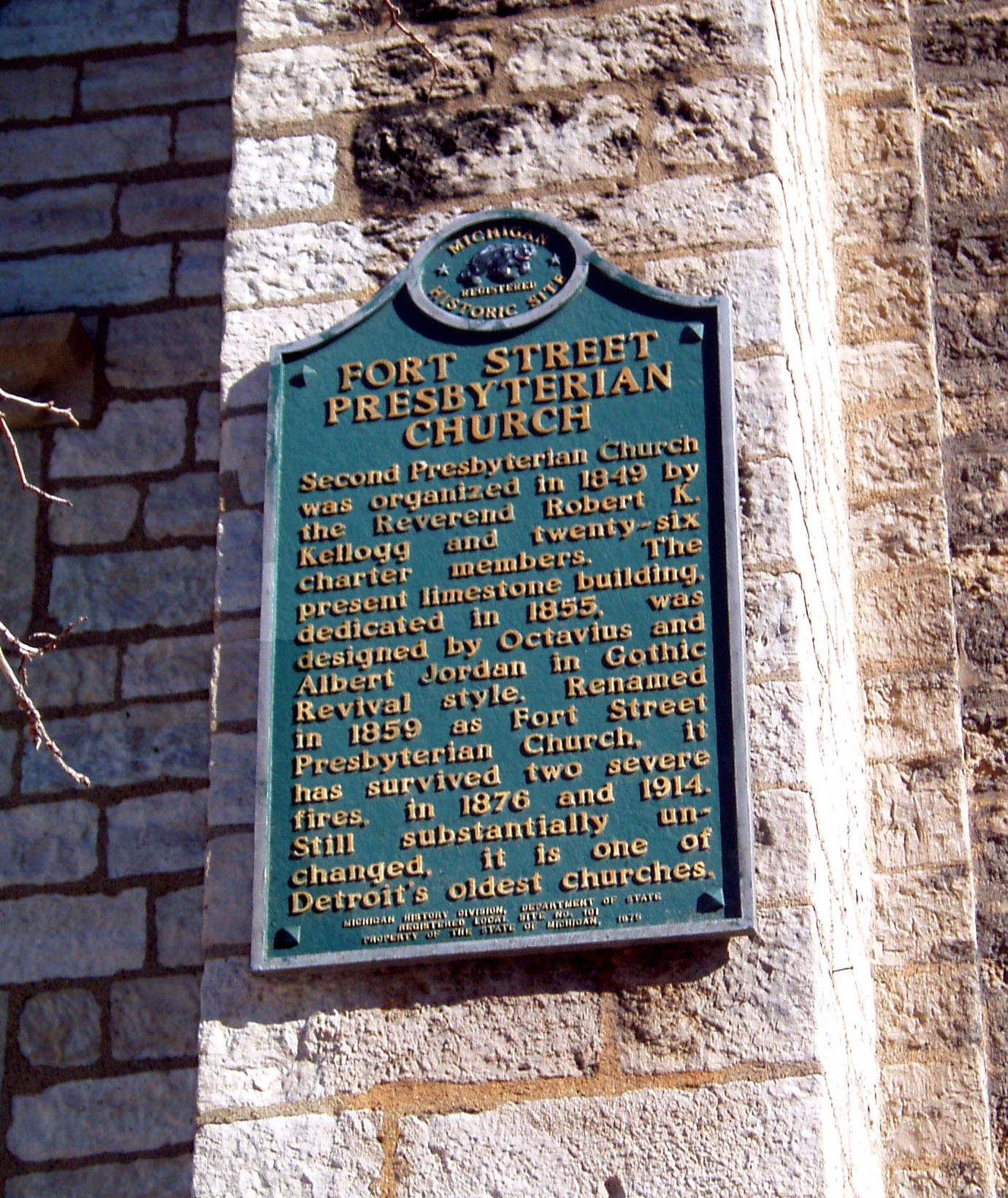Detroit was a remote French trading and farming village throughout
the Eighteenth century. For the first three decades of US history, it remained
a small French-speaking village on the distant frontier  despite the establishment
of a US
fort and the presence of the military who controlled Michigan's Indians.
After completion of the Erie Canal in 1825, Detroit's population increased,
albeit with a major setback due to the cholera epidemic of 1832 and 1833.
Shortly thereafter, the population grew rapidly and an English Protestant
elite came to the fore.
despite the establishment
of a US
fort and the presence of the military who controlled Michigan's Indians.
After completion of the Erie Canal in 1825, Detroit's population increased,
albeit with a major setback due to the cholera epidemic of 1832 and 1833.
Shortly thereafter, the population grew rapidly and an English Protestant
elite came to the fore.
In 1849, the Reverend Robert Kellogg, with 26 charter members, organized the Second Presbyterian Church. The congregation had a church near downtown Detroit but it was destroyed by fire in January, 1854. Population was growing to the southwest of downtown so the Presbyterians opted to build their replacement church in that area. They purchased land at the interesection of West Fort and Third Strseet. This was very close to the Michigan Central Railroad depot that was located at Third and West Jefferson until the present Michigan Central depot opened in 1912. Albert Jordan and his brother Octavius were leading architects in Detroit in the mid-1850s, having arrived from Hartford in 1852. The Second Presbyterian congregation selected the Jordan brothers to design this impressive church. The authors of Detroit's Historic Places of Worship - cited below - suggest that it wasw a draftsmen working for the Jordans - James Anderson - actually designed much of the church. The other spectacular Detroit church designed by the Jordans is St. John's Episcopal on Woodward near Comerica Park.
This is a Gothic Revival limestone ashlar structure
with, as you can observe, ornate detail. There are seven bays along the side
of the church with a 230-foot square tower balanced by a shorter octagonal
turret modeled after King's College Chapel in Cambridge. Note the flying buttresses,
the crocketed finials, the lacy stonework and the tall windows, all designed
to give the impression of lightness. To the best of my knowledge, lacy stonework
was an accomplishment of the 19th century, but not the 20th or 21st. You will
also observe the Jordan's "lacy" treatment of limestone in St.
John's Episcopal Church. The interior of this church offers testimony to
the creativity
of the Jordans, as well as the aspirations and prosperity of this congregation.
The three-aisle nave and horseshoe balcony seat almost 1,000. In 1850, the
census counted only 21,000 Detroit residents. The baptismal font is made
of Caen stone—a fine-grained white and yellow limestone imported from
France—supported
by columns of onyx imported from Mexico—all this completed a decade
before General Lee's surrender at Appamatox. The gray limestone used to construct this church came from Amherstburg, Ontario.
This church illustrates an interesting development in American architecture.
Thomas Jefferson advocated that this nation's architects should borrow from
the classical ideals of Greece and Rome. Think about what you see when you
visit the nation's magnificent governmental buildings in Washington—modern
day representations of what the Greek and Roman architects built. By the
third decade of the 19th century, American architects grew tired of imitating
their
Greek and Roman predecessors and turned to England for inspiration. Some
found it in the medieval cathedrals built there. The Jordans were of this
school
and so the created this marvelous Victorian Gothic Revival church.
The original building was completed in 1855. However, much of it was destroyed by fire in 1876. Apparently only the walls remained but it was rebuilt according to the original architectural plans in 1877. There was a major fire again in 1914 that destroyed some of the roof of the sanctuary, but the following year, this impressively attractive church was rebuilt according to the way it had been designed by the Jordan brothers in the mid-1850s. An organ was installed in 1855 but it was replaced with a very large and impressive organ constructed by Wangerin-Weickhardt or Milwaukee in 1914 - an organ that contains 3253 pipes. Every December, performances of Handel's Messiah are presented at Fort Street Presbyterian.
The building just north of the church was constructed in 1908. It contains a chapel, a gynasium and other facilities.
Very informative and flattering pictures of the interior of this church and is stained glass windows are included in the book Detroit's Historic Places of Worship.
Architects: Octavius and Albert Jordan
Architectural style: Gothic Revival
Date of completion: 1855, but rebuilt in 1877 and then again in 1915
Use in 2012: Identical to the use in 1855 when it was completed
Website for this church: www.FortStreet.org
For additional information see: Marla O. Collum, Barbara E. Krueger and Dorothy Kostuch, Detroit's Historic Places of Worship
(Detroit: Wayne State University Press, 2012
State historical register: P25116, Listed: March 3, 1971
State historical marker: Erected: October 3, 1975
National Register of Historical Places: Listed: September 3, 1971
Photo: Ren Farley; August, 2002
Description updated: December, 2012